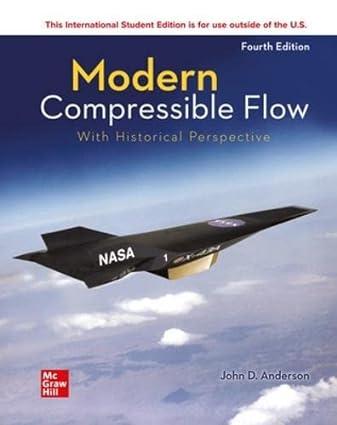In Probs. 5.20 and 5.21, we noted that the reservoir temperature required for a continuous flow air
Question:
In Probs. 5.20 and 5.21, we noted that the reservoir temperature required for a continuous flow air Mach 20 hypersonic wind tunnel was beyond the capabilities of heaters in the reservoir. On the other hand, as discussed in regard to Fig. 7.1, the high temperature gas behind the reflected shock wave at the endwall of a shock tube can be expanded through a nozzle mounted at the end of the tube. This device is called a shock tunnel wherein very large reservoir temperatures can be created. The flow duration through a shock tunnel, however, is limited typically to a few milliseconds. This is the trade-off necessary to achieve a very high reservoir temperature. Consider a shock tunnel with a Mach 20 nozzle using air. The air temperature in the region behind the reflected shock (the reservoir temperature for the shock tunnel) is \(4050 \mathrm{~K}\). In the driven section of the shock tube, before the tube diaphram is broken, the air temperature is \(288 \mathrm{~K}\). Calculate the Mach number of the incident shock wave required to obtain a temperature of \(4050 \mathrm{~K}\) behind the reflected shock.
Data From Problem 5.21:
The reservoir temperature calculated in problem 5.20 is beyond the capabilities of heaters in the reservoir of continuous-flow wind tunnels using air. This is why you do not see a Mach 20 continuous-flow tunnel using air. On the other hand, consider the flow of helium, which has a liquefaction temperature of \(2.2 \mathrm{~K}\) at the low pressures in the test section. This temperature is much lower than that of air. For a Mach 20 wind tunnel. For helium, the ratio of specific heats is 1.67.
Data From Problem 5.20:
As problems 5.18 and 5.19 reflect, the air temperature in the test section of conventional hypersonic wind tunnels is low. In reality, air liquefies at a temperature of about \(50 \mathrm{~K}\) (depending in part on the local pressure as well). In the practical operation of a hypersonic wind tunnel, liquefaction of the test stream gas should be avoided; when liquefaction occurs, the test stream is a two-phase flow, and the test data is compromised. For a Mach 20 tunnel using air, calculate the minimum reservoir temperature required to avoid liquefaction in the test section.
Data From Problem 5.19:
Consider a hypersonic wind tunnel with a reservoir temperature of \(3000 \mathrm{~K}\) in air. Calculate the theoretical maximum velocity obtainable in the test section. Compare this result with the results of problem 5.18 (a) and (b).
Data From Problem 5.18:
Consider two hypersonic wind tunnels with the same reservoir temperature of \(3000 \mathrm{~K}\) in air.
(a) One tunnel has a test-section Mach number of 10. Calculate the flow velocity in the test section.
(b) The other tunnel has a test-section Mach number of 20. Calculate the flow velocity in the test section.
Step by Step Answer:






